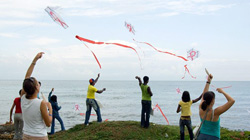
This month marks the 50th anniversary of the Peace Corps, and I would like to thank the thousands of volunteers who have responded to the HIV/AIDS crisis, one of the most serious threats to global health and development. The Peace Corps is a key partner and implementer of the U.S. President's Emergency Plan for AIDS Relief (PEPFAR), which is working around the globe to save lives and promote a more secure world.
When PEPFAR was announced in 2003, Peace Corps was recognized as a key partner in the U.S. government's response to the global AIDS pandemic. Today, nearly 2,500 volunteers are working on PEPFAR-supported HIV programs in 46 countries. Many Peace Corps volunteers work on HIV education initiatives during their service. The Peace Corps currently trains all volunteers who serve in Africa, the Caribbean, Eastern Europe, and Central Asia to be advocates and educators for HIV prevention, care, and support.
Volunteers will continue to be first responders in local communities, dealing with the unfolding tragedies in the villages were they serve. Volunteers' “can do” attitudes mean that they find ways to “make do.” Where others may see a lack of resources, Peace Corps volunteers see a challenge and they respond with creative solutions. They contribute a clear understanding of what really works to fight the spread of disease and alleviate suffering.
Peace Corps volunteers help communities affected by HIV through work with businesses, community organizations, and non-governmental organizations, and through efforts in areas such as public health education. While volunteers do not provide direct medical services, they are important partners in directing people to HIV programs and helping them to stay in care.
Volunteers also provide critical support by working with communities to reduce risks that contribute to the spread of HIV. They speak with communities and lead by example. Volunteers encourage HIV testing, teach about nutrition, and help to reduce stigma and discrimination. Due to their compassion and leadership in helping those affected by HIV, Peace Corp volunteers are often accepted as members of the communities in which they work. Volunteers quickly come to think of these communities as family.
In my travels, I am invariably impressed by the energy, passion and out-of-the-box thinking that volunteers bring to their work in HIV. During my recent visit to Botswana, I had the pleasure of meeting with Peace Corps volunteers who are working in health district offices, clinics, and schools to support the leadership of local communities in responding to HIV/AIDS. Their leadership is helping to save lives and promote a more secure world.
As we focus PEPFAR programs on supporting countries as they work to improve the health of their own people, Peace Corps and its dedicated volunteers will continue to be vital to our success in building capacity and promoting a lasting response. I salute Peace Corps on the occasion of their 50th anniversary and welcome their continued contributions to PEPFAR and U.S. global health efforts.


Thank you for this blog post. As a long time public health employee working in the field of HIV/AIDS, I am inspired by the work of the Peace Corps volunteers. I have often considered taking a leave of absence from my paid employment in Ohio to work on HIV/AIDS issues in other parts of the world. It is good to know that the Peace Corps might be a good place to put my energy.
Thanks again!
Yay for Peace Corps! Through a PEPFAR grant, I helped educate over 1,500 Honduran high school students and teachers about HIV/AIDS.